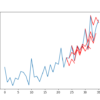Long Short-Term Memory (LSTM) networks are a type of recurrent neural network capable of learning order dependence in sequence prediction problems. This is a behavior required in complex problem domains like machine translation, speech recognition, and more. LSTMs are a complex area of deep learning. It can be hard to get your hands around what […]










